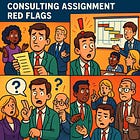When Projects Get Tough: A Consultant’s Guide to Surviving and Thriving
9 Common Consulting Challenges – and How to Tackle Them Without Burning Out
If you spend enough time in consulting, one thing is certain: not every project will be smooth sailing. Some will stretch you in good ways, others will test your patience, and a few will make you wonder why you ever signed up in the first place.
Challenging projects are part of the game. They’re also where we often learn the most—about clients, about our craft, and about ourselves.
Here are some of the most common types of project challenges consultants face—and practical ways to navigate them.
1. Fuzzy, Undefined, or Conflicting Goals
The challenge:
You’ve been staffed, the project has kicked off… and no one seems to agree on what success actually looks like. Sometimes it’s pure ambiguity—other times, stakeholders actively have conflicting priorities. One leader wants cost savings, another demands innovation, and a third insists on compliance. Left unchecked, this pulls the project in different directions and frustrates everyone involved.
How to deal:
Surface the ambiguity instead of ignoring it.
Facilitate a discussion with stakeholders to align on outcomes.
Write down and confirm the agreed objectives—no matter how basic.
Revisit them regularly, especially if priorities shift.
If conflicts persist, escalate carefully and ensure trade-offs are made explicit.
Clarity is your best friend. Without it, everything else becomes harder.
2. Complex Subject Matter
The challenge:
You’ve been parachuted into a technical, regulatory, or highly niche domain you’ve never touched before. The acronyms fly past, the client team assumes shared knowledge, and you may feel like everyone else is speaking a foreign language. It can be intimidating—and risky—because you still need to add value.
How to deal:
Learn “just enough” to be credible—don’t waste time chasing instant mastery.
Build a quick network of experts (inside and outside the client) you can tap into when things get too deep.
Focus on what outsiders see most clearly: inconsistencies, assumptions, and missing links. Those “naive” questions often unlock real progress.
Structure the messy domain. Clients may know the details, but consultants add value by creating clarity: models, diagrams, roadmaps.
Remind yourself: your worth isn’t in being the deepest expert in the room, but in connecting dots, framing issues, and making complexity understandable.
In fact, many clients value consultants precisely because they aren’t insiders—your fresh perspective can challenge assumptions that everyone else takes for granted.
3. Missing Skills in the Team
The challenge:
Sometimes you (or your whole team) simply don’t have all the skills the project demands. Maybe a key technology or domain expertise is missing. It’s uncomfortable, because clients expect capability and confidence—but inside, you may be scrambling to fill the gap.
How to deal:
Be honest early. Don’t promise expertise you can’t deliver—flag the gap before it becomes a risk.
Tap into your firm’s network. Often the skill exists somewhere else internally. Bring that person in, even part-time.
Partner smartly. Sometimes the right move is to collaborate with a subcontractor or specialist rather than trying to fake it.
Learn just enough to hold meaningful conversations while specialists handle the depth.
Reframe your role: you don’t need to know everything—you need to create structure, clarity, and connect the right people.
Skill gaps are not career-ending. They’re an inevitable part of consulting. The key is whether you try to hide them, or manage them openly and constructively.
4. Difficult Client or Stakeholder
The challenge:
Sometimes the hardest part of the work isn’t the deliverable or the subject matter—it’s the person across the table. A client doesn’t trust you, resists every recommendation, or communicates in ways that feel dismissive or even hostile. Sometimes it’s personality. Sometimes it’s office politics. Either way, it drains energy fast and can stall momentum.
How to deal:
Stay professional—even if they don’t. Don’t get pulled into the same emotional tone.
Look for small wins that build trust, one step at a time. A single delivered promise can change dynamics.
Find allies: supportive stakeholders who see the value of your work and can amplify your message.
Separate the person from the issue. Often, resistance isn’t really about you—it’s about organizational history, competing priorities, or fear of change.
If the relationship stays toxic, escalate constructively. Protect your own well-being while keeping the project on track.
Consulting is a people business. Solving technical problems is often easier than solving relationship problems, but both are part of the job.
5. Difficult Project Lead (from Your Own Firm)
The challenge:
Not every obstacle comes from the client side. Sometimes it’s your own project lead or manager. They might micromanage every detail, provide vague direction but sharp criticism, push unrealistic deadlines, or be more focused on internal politics than delivering client value. This can sap motivation and create friction within the team.
How to deal:
Proactively clarify expectations instead of waiting for instructions to land.
Communicate openly about blockers and offer options, not just problems.
Manage up: anticipate needs, prepare what you know they’ll ask for, and keep updates short and structured.
If things remain unsustainable, escalate through the right channels—but keep it professional.
The goal isn’t to “fix” the project lead but to protect your own work, keep the client relationship healthy, and avoid unnecessary conflict inside your firm.
6. Too Few Resources, Too Much Work
The challenge:
The project is understaffed, deadlines are unrealistic, and expectations keep growing. You can’t create miracles out of thin air—but somehow, that seems to be the requirement. This is one of the fastest ways for a project (and its people) to burn out.
How to deal:
Raise the issue early, not when the deadline is already on fire. Leaders need time to react.
Prioritize visibly: “We can do A and B by next week, but not C unless we drop D.” Clarity makes trade-offs explicit.
Propose practical alternatives: phased delivery, reduced scope, or extending timelines. “This won’t work” lands better when paired with “Here’s what could.”
Take care of your own boundaries. Long hours and endless stretch only work short term. Unsustainable delivery helps no one.
Being the voice of realism isn’t always comfortable, but clients respect consultants who balance ambition with honesty.
7. Scope Creep Without End
The challenge:
The original plan was clear, but little by little, “just one more thing” keeps sneaking in. Before long, the side asks outweigh the actual project. Left unchecked, scope creep destroys focus, timelines, and morale.
How to deal:
Document every new request and spell out its impact—time, cost, resources. Ambiguity is scope creep’s best friend.
Always ask: “If we add this, what should we remove or delay?” Force the trade-offs into the open.
Use governance (steering committees, sponsors) to reset boundaries when needed. You can’t hold the line alone forever.
Spot patterns: sometimes scope creep signals that the original need wasn’t defined well enough. Take a step back to reframe the scope.
Scope creep isn’t always bad. It can mean the client trusts you and wants more. But unmanaged, it can sink even the best project.
8. Politics and Power Games
The challenge:
Your project is caught in the middle of an internal turf war. Leaders have competing agendas, alliances shift, and suddenly your deliverable is a proxy battle for influence. It’s exhausting—and dangerous—because the real issues often have nothing to do with your work.
How to deal:
Stay neutral. Don’t let yourself be pulled into “sides,” even subtly.
Stick to facts, data, and agreed objectives—something that transcends politics.
Communicate transparently so no one can accuse you of backroom maneuvering. Visibility is protection.
Identify decision-makers who actually have the authority to resolve conflicts and keep escalating there.
Protect yourself emotionally. You can’t control the politics, but you can control how much it drags you in.
You’re not there to play politics, but you do need to navigate it wisely. Sometimes, survival is about being trusted by all sides without belonging fully to any.
9. Organizational Culture and Barriers
The challenge:
Sometimes the hardest part of a project isn’t the client’s technical problem—it’s the client organization itself. Decisions get stuck in endless approval loops. Teams work in silos and refuse to share information. Hierarchies slow everything down, or a “this is how we’ve always done it” mindset resists every new idea. Even the best solution struggles to gain traction in this kind of environment.
How to deal:
Acknowledge the cultural challenge instead of pretending it’s just a process issue.
Map the decision-making landscape: who really influences outcomes, and how do things get approved?
Build coalitions by finding allies across departments or functions.
Celebrate and showcase small wins to prove change is possible.
Stay patient but realistic. Sometimes your role is to help the client see the cultural barrier itself.
Culture won’t change overnight, but recognizing it early helps you adapt your approach—and keeps you from burning energy on resistance that’s bigger than you.
So, What’s the Big Picture?
Challenging projects aren’t exceptions—they’re part of consulting life. And paradoxically, they’re often the ones that teach you the most:
How to find clarity when none exists.
How to adapt quickly to new domains.
How to build trust, even with skeptics.
How to set boundaries without burning bridges.
But here’s the caveat: there’s a fine line between “challenging” and “unsustainable.” A tough project can accelerate your growth—unless it pushes you toward burnout. If the demands become overwhelming and no amount of prioritization or escalation helps, the real lesson may be knowing when to protect your energy and say no.
If you take one thing away, let it be this: hard projects aren’t career failures—they’re career accelerators when navigated well. You’ll remember the messy ones long after the smooth ones fade from memory, but only if you emerge stronger, not exhausted.
Final Thoughts
Every consultant has war stories of projects that went sideways—or at least felt like uphill battles. The key isn’t avoiding them (you can’t). It’s learning how to navigate them without losing your sanity, your professionalism, or your perspective.
And who knows? The project you dread today might be the one you talk about in job interviews—or mentor someone else about—years from now.
See you next time,
Eetu Niemi
IT Consulting Career Hub 🚀
📚 Related Reads from the IT Consulting Career Hub
If this topic resonated with you, you might also enjoy:





